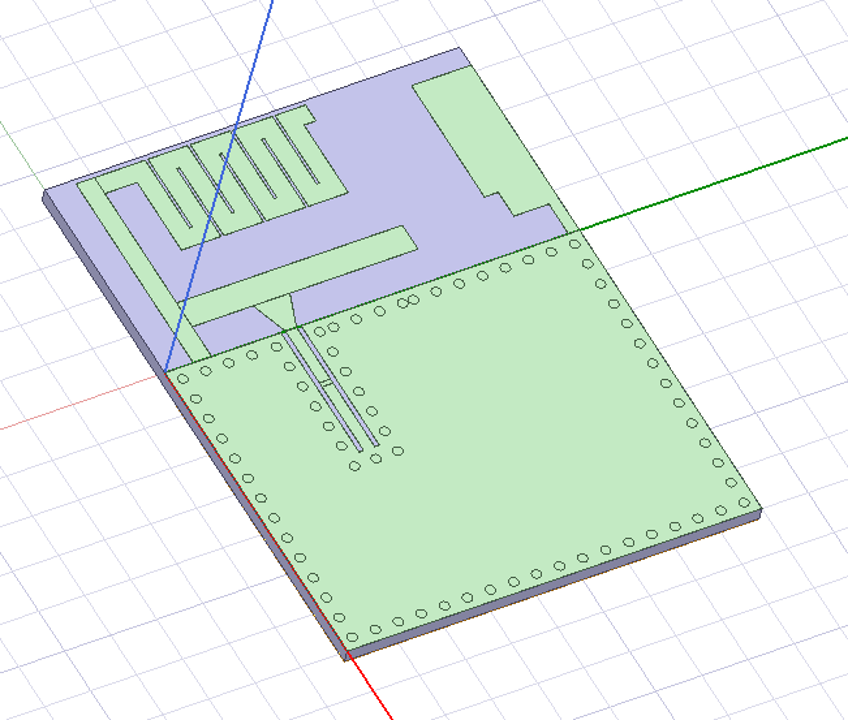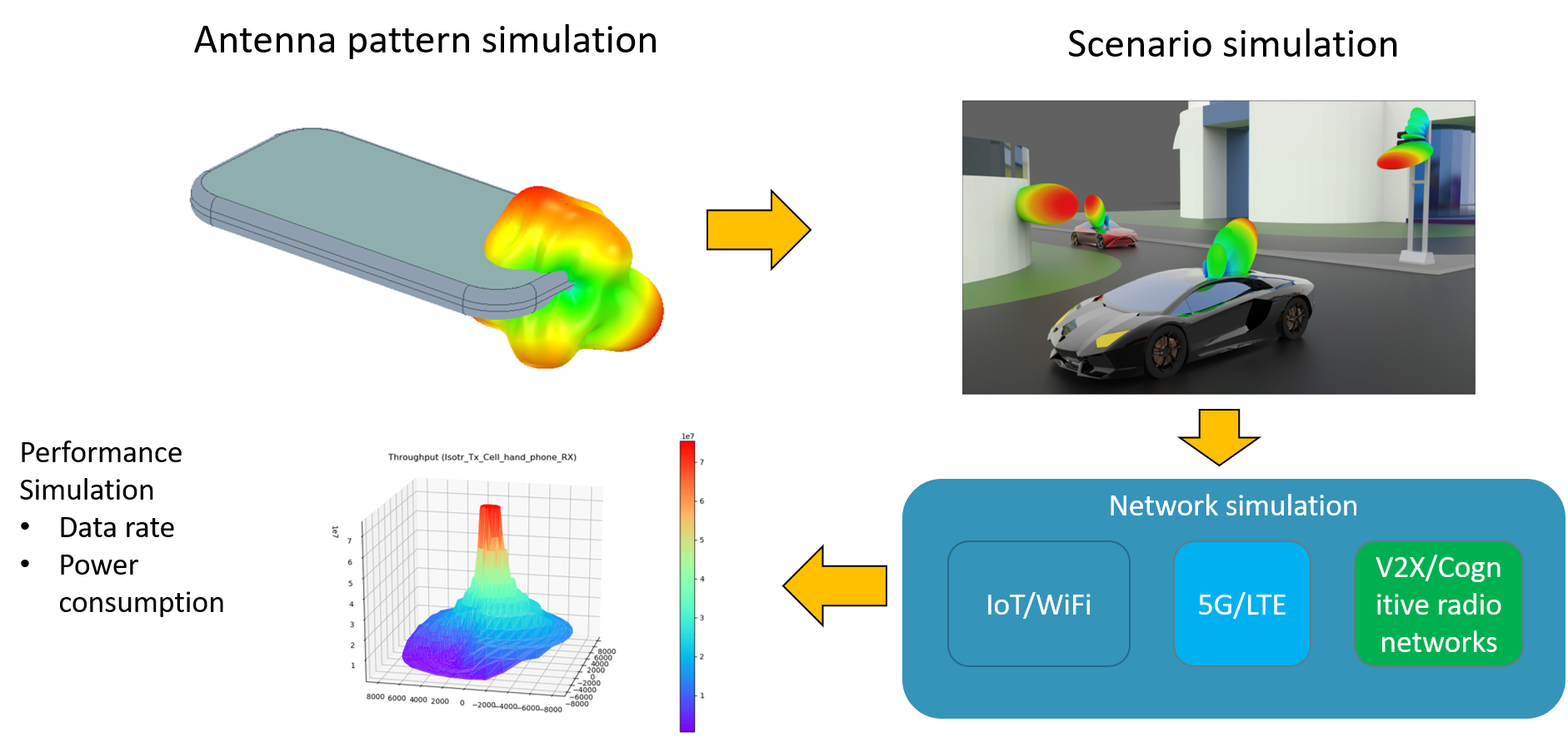Antenna simulation
Chip antenna
Off the shelf antenna
Many wireless systems starts with an off the shelf antenna such as a chip, PCB or dipole antenna. Typically, you won’t know how well it is going to work until the full system prototype is done. Then you find out it isn’t quite as good as you’d hoped. Low communications data rate, high power use, mysterious dropped connection are some of the issues systems engineers struggle with.
We are uniquely able to predict the performance of your antenna system at the design stage. This means you will finally have a chance to optimize and improve your wireless performance.
Antenna matching and frequency response
Most communications systems today needs to work across a range of frequencies. We perform antenna matching at the design stage to integrate antennas to your systems and make sure it has the right frequency response.
Antenna frequency response
Antenna radiation pattern on bare PCB
Antenna radiation pattern in hand
Antenna radiation pattern simulation
Antenna patterns determines the directional performance of your communication system. It is highly sensitive to nearby metals and dielectrics.
The installed directional performance of your antenna is usually very different compared to your data sheets.
We offer state of the art simulation tools to predict your installed antenna pattern. This ensures the antenna is “pointed” in the right direction which helps to reduce power usage and improve performance.
Antenna performance
Do you want to know what is the installed performance of your device? What is the data transfer rate, power usage or through put?
Singularity engineering is uniquely able to provide these performance metric early-on in the design process.
We take the simulated system level antenna radiation pattern, integrate this in to a virtual scenario. Using state of the art network simulation tools, we are able to predict realistic wireless communications performance for a wide range of protocols.
Antenna performance scenario
Data rate vs position
Antenna miniaturization
Off the shelf antenna reference design
Off the shelf antenna - smaller form factor, however the antenna and attached traces are identical
Miniaturizing the antenna
A main reason engineers seek custom antenna designs is the need to fit the antenna into the required form factor. Reference design boards are often impractical for the device due to overall size and the need to place additional components on the PCB.
However reducing the size of the reference design can cause significant changes to the antenna performance.
Reference design antenna patterns
Miniaturized design antenna patterns
Antenna patterns change
Antenna patterns tells us which direction the the antenna will work well in (red areas result in strong signals, blue regions results in weaker signal). In many applications, a omni-directional antenna pattern is preferred, in some applications a focused pattern is more beneficial. In the dual band communications antenna, the pattern changes significantly when the PCB is miniaturized. Even though the antenna and surrounding traces are identical.
Reference design frequency response
Miniaturized antenna frequency response
Frequency response change
Frequency response show the ability of an antenna to radiate energy efficiently at the right frequencies (lower values on the graph is better). Dual band/wide band antennas need to radiate well across a wide range of frequencies.
The figures above shows performance changes greatly for a wide range of frequencies with only a change in the size of the PCB.
Conclusion
Reducing the size of the reference design and fitting the antenna into a device is an important part of the wireless system development process. However any changes in the PCB, housing and components can affect the antenna performance.
Our simulation solutions allows engineers to quickly iterate and tune the antenna to understand performance vs size trade-offs in standard off the shelf antennas.
Custom antenna design
Custom antenna designs provides the ultimate flexibility in antenna performance, form factor and placement. They can be carefully designed to optimize for the performance, size and directionality.
Custom multiband LTE communications antenna designed by Singularity Engineering.
custom Antenna size
Custom antenna can be fit onto the PCB directly or added on a flex PCB or other parts. This provides the versatility to fit these antenna into a device efficiently with optimal performance.
Custom antenna frequency response
Custom antenna performance
Custom antenna have the ultimate flexibility to meet and exceed communications performance requirement. Here is a smaller antenna that significantly out performs off the shelf systems. This reduces energy usage, and increase data rates.
Antenna patterns
Far field radiation patterns
Custom antenna patterns
Custom antennas can be designed to have unique radiation patterns. This allows communications energy to be directed in specific directions.
System performance simulation
What is system performance simulation
System performance simulation is a unique capability developed by Singularity engineering. It simulates antenna systems with real RF communications system software stack and various deployment scenarios. This allows us to quantify system level performance you are about such as
Data through put as a function and distance and orientation
Power usage at certain range and data rate.
Network interference due to multiple user equipment
System performance simulation combines antenna radiation patterns with deployment scenarios and full network simulators. The provides unmatched accuracy in system level performance predictions.
Accuracy
System performance simulation uses the following to provide the most accurate prediction of communications system performance.
Accurate antenna patterns - from simulation, measurements or data sheets
Antenna configurations - (siso, mimo, massive mimo)
Statistical scenario models, or map based scenario models
Channel bandwidth
Standard based modulation coding scheme
Data throughput simulation for different communications environment as a function of range.
Actionable ensight
This simulation solution provide the data engineers need to make the right trade-offs in their antenna and communications systems. Will the miniaturization results in unacceptable performance? Can an off the shelf antenna meet battery and data-rate requirements?
System performance simulation will provide these answers before your prototype.
Power usage for a Bluetooth system vs range.
Data throughput vs range
Thank you for visiting Singularityeng.com. Please let us know if there is anything we can help you with.
























